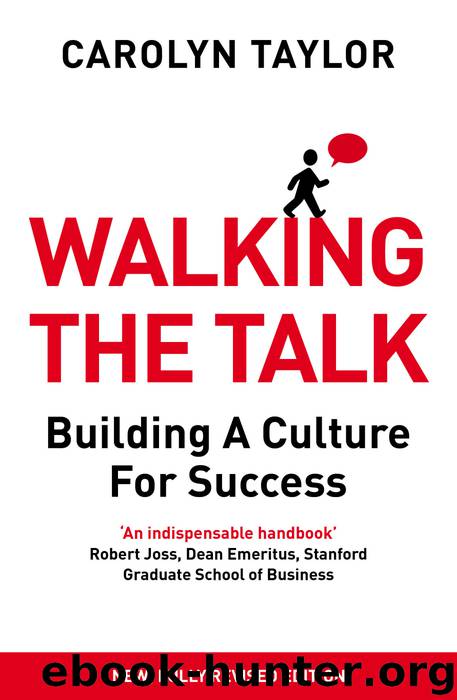Walking the Talk by Carolyn Taylor

Author:Carolyn Taylor
Language: eng
Format: epub
ISBN: 9781473535855
Publisher: Random House
3. Being valued – receiving recognition (including reward) for a contribution
When you think about making people feel valued, consider it on three levels:
Being valued for what I have achieved (outcomes)
Being valued for what I think (ideas)
Being valued for what I feel and who I am (being)
Everyone thrives on receiving recognition on some of these three – even those big tough people who say they don’t care! In creating opportunities for this to occur, it is useful to break it into these three categories, because strategies for each are quite different.
You would do well to direct some of your leadership-development work towards educating your people in the differences between each. Different kinds of people naturally incline towards one or the other. If you have adopted people as one of your values you must explore this in detail, because among these three lie the answers to some of the values dilemmas associated with people. For example, individuals who are not achieving outcomes cannot be permitted to continue to remain in this situation (they will need to be moved to a new role, coached or exited). However, even when they are not achieving outcomes they can still be valued for what they think and for who they are. In fact they are more likely to lift their performance game if they are feeling valued on other levels, because their positive motivation is stronger.
Valuing outcomes
Financial reward, of course, must be lined up as closely as possible to outcomes. If you are confident the cause-and-effect relationship between an individual and their outcomes can be measured, then higher variable pay will motivate.
Other forms of recognising contribution are important, through both formal and informal channels. Your plan can include mechanisms for recognition, such as contributor of the month awards and other such devices. These have the secondary benefit of sending a cultural message about what is important.
Valuing ideas
Set up forums to listen to those who are closest to the customer. Have lunches between your leaders and more junior staff. Ask your new employees how they find the culture and what could be done differently. Invite cross sections of people to strategy sessions. Design problem-solving groups. Create rituals for learning from each other, testing ideas with peers.
Valuing feelings
Ask questions and listen with empathy. If I have empathy with you it does not mean I have to agree with your view, but I have made it my job to understand why you held that view. What are your feelings, values and beliefs and experiences? Set up forums with this in mind. Bring leaders together with people for the purpose of listening and valuing someone else and how they feel. Remember what we talked about earlier about non-defensiveness!
Some of this can become part of your Culture Development Plan. Some of it comes naturally when your leaders increase the extent to which they really value people. Increasing their valuing of people occurs through the strategies described under the sections on changing values and beliefs.
3. Being valued – receiving recognition (including reward)
Download
This site does not store any files on its server. We only index and link to content provided by other sites. Please contact the content providers to delete copyright contents if any and email us, we'll remove relevant links or contents immediately.
Hit Refresh by Satya Nadella(8854)
The Compound Effect by Darren Hardy(8508)
Change Your Questions, Change Your Life by Marilee Adams(7373)
Nudge - Improving Decisions about Health, Wealth, and Happiness by Thaler Sunstein(7242)
The Black Swan by Nassim Nicholas Taleb(6764)
Deep Work by Cal Newport(6563)
Daring Greatly by Brene Brown(6224)
Rich Dad Poor Dad by Robert T. Kiyosaki(6175)
Principles: Life and Work by Ray Dalio(5961)
Man-made Catastrophes and Risk Information Concealment by Dmitry Chernov & Didier Sornette(5647)
Playing to Win_ How Strategy Really Works by A.G. Lafley & Roger L. Martin(5500)
Digital Minimalism by Cal Newport;(5389)
Big Magic: Creative Living Beyond Fear by Elizabeth Gilbert(5351)
The Myth of the Strong Leader by Archie Brown(5237)
The Slight Edge by Jeff Olson(5200)
Discipline Equals Freedom by Jocko Willink(5157)
The Motivation Myth by Jeff Haden(5003)
Stone's Rules by Roger Stone(4857)
The Laws of Human Nature by Robert Greene(4773)
